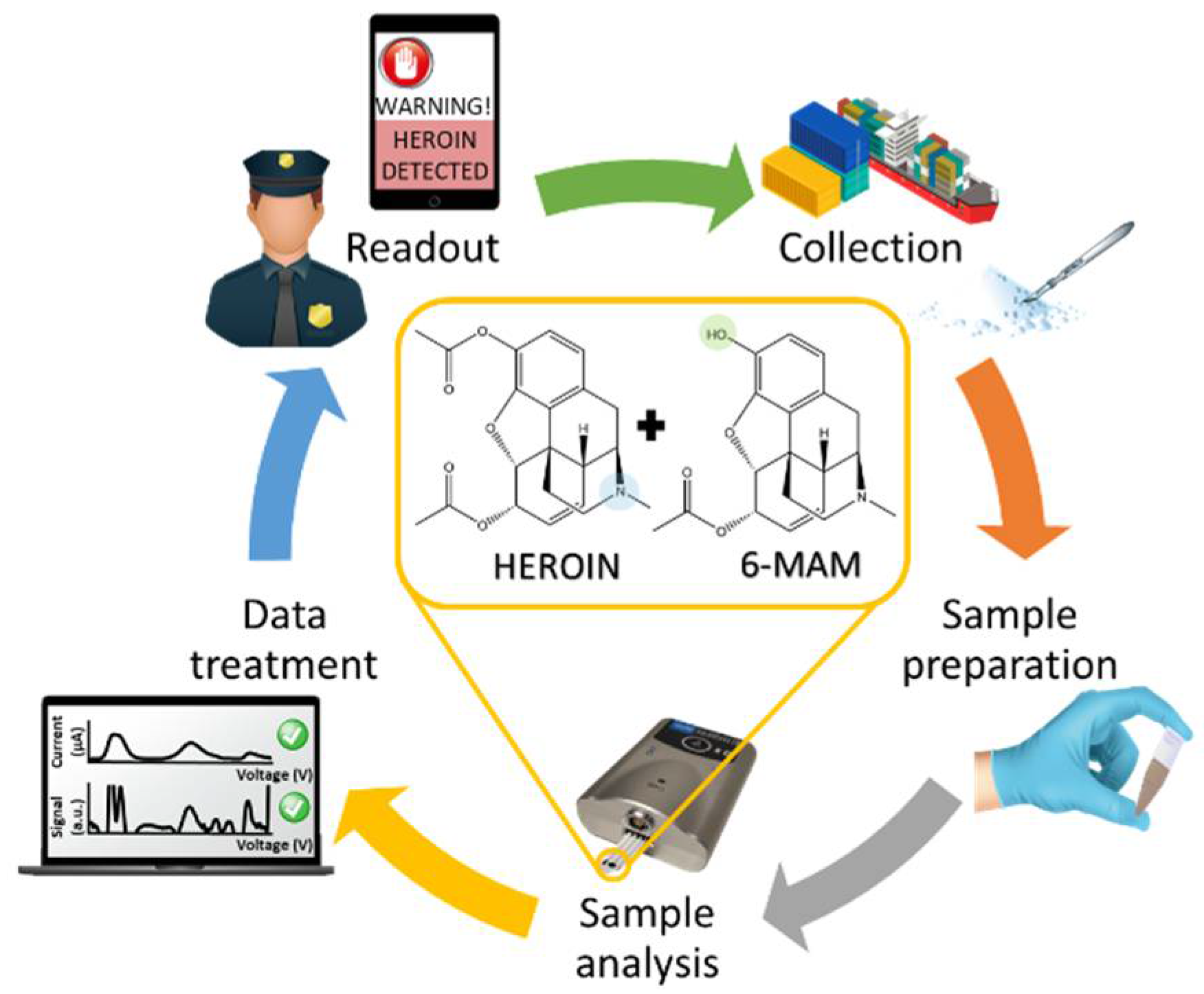Highly Selective Electrochemical Profiling of Heroin in Street Samples †
Supplementary Materials
Author Contributions
Funding
Conflicts of Interest
References
- EU Drug Markets Report 2020; European Monitoring Centre for Drugs and Drug Addiction: Lisbon, Portugal, 2020.
- EU Drug Markets Report 2019; European Monitoring Centre for Drugs and Drug Addiction: Lisbon, Portugal, 2019.
- De Araujo, W.R.; Cardoso, T.M.G.; da Rocha, R.G.; Santana, M.H.P.; Muñoz, R.A.A.; Richter, E.M.; Paixão, T.R.L.C.; Coltro, W.K.T. Portable analytical platforms for forensic chemistry: A review. Anal. Chim. Acta. 2018, 1034, 1. [Google Scholar] [CrossRef] [PubMed]
- Teymourian, H.; Parrilla, M.; Sempionatto, J.R.; Montiel, N.F.; Barfidokht, A.; van Echelpoel, R.; de Wael, K.; Wang, J. Wearable Electrochemical Sensors for the Monitoring and Screening of Drugs. ACS Sens. 2020, 5, 2679. [Google Scholar] [CrossRef] [PubMed]
- Truta, F.; Florea, A.; Cernat, A.; Tertis, M.; Hosu, O.; de Wael, K.; Cristea, C. Tackling the Problem of Sensing Commonly Abused Drugs Through Nanomaterials and (Bio)Recognition Approaches. Front. Chem. 2020, 8. [Google Scholar] [CrossRef] [PubMed]

Publisher’s Note: MDPI stays neutral with regard to jurisdictional claims in published maps and institutional affiliations. |
© 2022 by the authors. Licensee MDPI, Basel, Switzerland. This article is an open access article distributed under the terms and conditions of the Creative Commons Attribution (CC BY) license (https://creativecommons.org/licenses/by/4.0/).
Share and Cite
Felipe Montiel, N.; Parrilla, M.; Beltrán, V.; Nuyts, G.; Van Durme, F.; De Wael, K. Highly Selective Electrochemical Profiling of Heroin in Street Samples. Eng. Proc. 2022, 27, 15. https://doi.org/10.3390/ecsa-9-13222
Felipe Montiel N, Parrilla M, Beltrán V, Nuyts G, Van Durme F, De Wael K. Highly Selective Electrochemical Profiling of Heroin in Street Samples. Engineering Proceedings. 2022; 27(1):15. https://doi.org/10.3390/ecsa-9-13222
Chicago/Turabian StyleFelipe Montiel, Noelia, Marc Parrilla, Victoria Beltrán, Gert Nuyts, Filip Van Durme, and Karolien De Wael. 2022. "Highly Selective Electrochemical Profiling of Heroin in Street Samples" Engineering Proceedings 27, no. 1: 15. https://doi.org/10.3390/ecsa-9-13222
APA StyleFelipe Montiel, N., Parrilla, M., Beltrán, V., Nuyts, G., Van Durme, F., & De Wael, K. (2022). Highly Selective Electrochemical Profiling of Heroin in Street Samples. Engineering Proceedings, 27(1), 15. https://doi.org/10.3390/ecsa-9-13222






